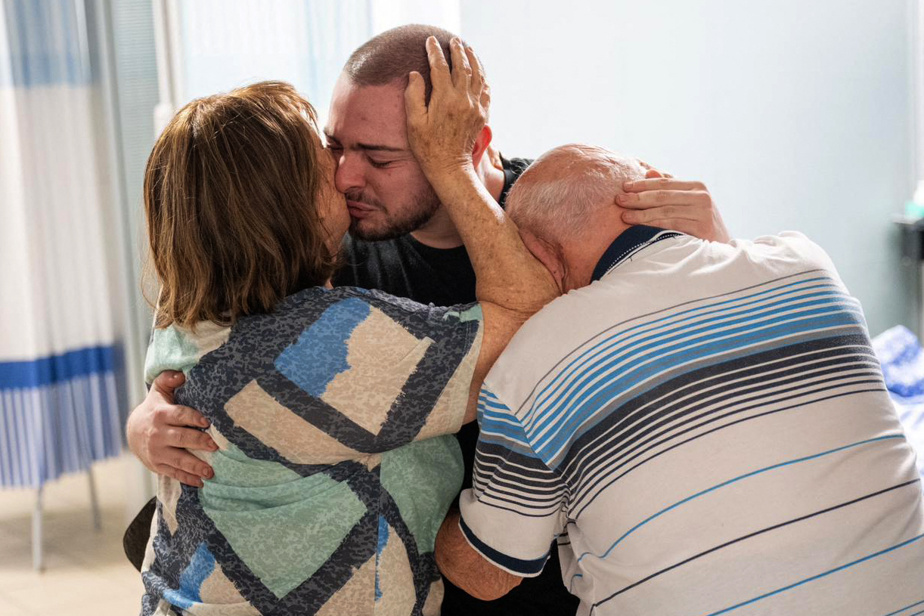The delivery of humanitarian aid to Gaza resumed on Saturday via the temporary American jetty, the United States military announced, denying that the infrastructure was used to free the four Israeli hostages from a refugee camp where the movement Palestinian Islamist Hamas reported 210 people killed.
The American army said it had delivered, from the temporary artificial port repaired after a storm off the coast of Gaza, nearly 500 tonnes of “essential” humanitarian aid to the 2.4 million inhabitants facing the risk of famine.
On the other hand, she denied that this bridge – “its equipment, its personnel and its installations” – was used in the operations to free the hostages.
“An area south of this facility was used by the Israelis to secure the return of hostages to Israel. Any other statement is false,” Centcom said in a statement.
The Israeli army also refuted the participation of American soldiers on the ground in the release of hostages, after press reports indicating American support for the operations.
“There were no American soldiers, nor any American participation on the ground in this operation,” Israeli army spokesperson Avichay Adraee told Mashhad TV.
Saturday morning, during “a difficult special daytime operation in Nusseirat, four Israeli hostages were freed,” the Israeli army wrote earlier in a statement, in the ninth month of war against Hamas.
They are Noa Argamani, 26, Almog Meir Jan, 22, Andrey Kozlov, 27, and Shlomi Ziv, 41, all four “abducted” from the site of the Nova electro music festival during the he unprecedented attack carried out on Israeli soil by Hamas on October 7, which sparked hostilities, according to the army.
Israeli Prime Minister Benjamin Netanyahu said the release of the hostages was proof that Israel was not giving in “in the face of terrorism.”
A video posted on social media shows the emotional reunion between Noa Argamani and her father, as well as Israelis at the beach shouting with joy as they heard a lifeguard announce the release of the hostages.
The hostages, according to the military, are “in good health” and have been transferred to a medical center near Tel Aviv. Israeli police announced the death of one of their officers in the operations.
For its part, Hamas announced on Saturday a toll of at least 210 dead and more than 400 injured in Israeli attacks on the Nousseirat camp. The Hamas press release does not mention the release of hostages.
Saying she was “relieved” at the release of the hostages, the UN special rapporteur in the Palestinian territories Francesca Albanese deplored on X that it was “at the cost of at least 200 Palestinians, including children, killed and more than 400 injured”.
“This horror must stop,” UN Secretary General Antonio Guterres insisted on X.
Hamas leader Ismail Haniyeh said in a statement from Doha that the “resistance” would “continue.”
French President Emmanuel Macron welcomed the release of the four Israeli hostages, with his American counterpart Joe Biden assuring Saturday in Paris that the United States would continue to mobilize until “all” were released.
The Hostage Families Forum hailed a “miraculous triumph,” urging the government and the international community to secure the release of the remaining captives.
Before the announcement on the hostages, the Israeli army said on Saturday that it was targeting “terrorist infrastructure” in Nousseirat, while witnesses reported shooting from drones and helicopters against the camp.
Dr. Khalil al-Dakran, a spokesman for Al-Aqsa Hospital in Deir al-Balah, near Nusseirat, said 15 people had died in “intense Israeli strikes” that he said left dozens more injured.
Intense clashes between the army and Palestinian fighters are taking place in the al-Bureij and neighboring al-Maghazi camps, according to witnesses.
In a statement, the Israeli army said it struck “dozens of terrorist cells and infrastructure, including a tunnel located in a civilian structure” during operations in Bureij and Deir al-Balah.
In the south, artillery bombardments hit several areas of the town of Rafah, on the Egyptian border, according to local sources.
The attack carried out on October 7 by Hamas commandos infiltrated from Palestinian territory resulted in the deaths of 1,194 people, the majority civilians, according to an AFP count based on official data.
During this attack, 251 people were taken as hostages. After a short truce in November which allowed the release of around a hundred of them, 116 hostages are still being held in Gaza, 41 of whom are dead, according to the Israeli army.
Israel has vowed to destroy Hamas, which took power in Gaza in 2007 and which it considers a terrorist organization along with the United States and the European Union.
His army launched a deadly offensive in the small coastal territory. At least 36,801 Palestinians, mostly civilians, were killed, according to data from the Health Ministry of the Hamas-led Gaza government.
While diplomatic efforts to secure a truce stall, US Secretary of State Antony Blinken is expected next week in Israel, Egypt, Qatar and Jordan, to “promote a ceasefire proposal” presented recently by President Joe Biden, according to Washington.
According to the Wall Street Journal, citing sources familiar with the matter, Qatar and Egypt recently threatened Hamas officials with arrest and expulsion from Doha, where they are based, if they did not agree to a truce with Israel.
In Israel, Benny Gantz, the former army chief who became Benjamin Netanyahu’s political rival, who was to announce his resignation from the war cabinet on Saturday evening, canceled his intervention shortly after the announcement of the release of the hostages.
He demanded the adoption of an “action plan” on the post-war in the Gaza Strip, failing which he would be “forced to resign from the government”, which he had joined after October 7.
Mr. Netanyahu urged his rival not to leave his government, stressing that it was time for “unity, not division.”




